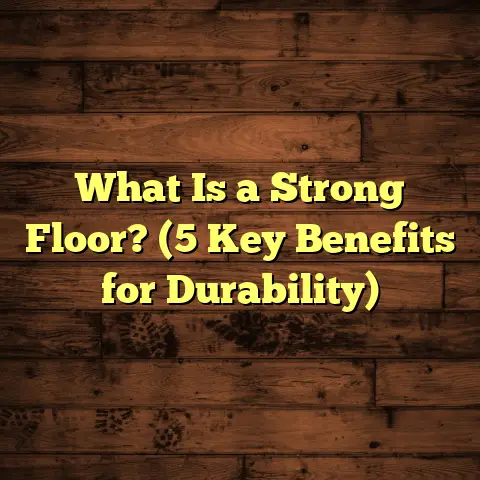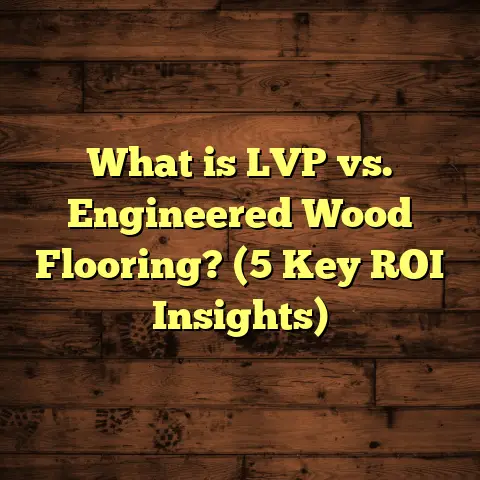What is Floor Covering Carpet? (5 Benefits You Should Know)
I once came across a surprising fact that stuck with me: the carpet industry in the U.S. alone pulls in over $16 billion annually. At first, I thought, wow, that’s a huge number for something as ‘simple’ as carpeting. But then I started thinking about how many places I’ve been where carpet completely changes the feel of a room — from cozy homes to bustling hotels and busy offices.
Carpet is everywhere, yet most people don’t pause to think about what makes it so popular or valuable as a floor covering. As someone who’s spent years installing and working with all kinds of flooring, I’ve come to appreciate carpet beyond just its looks. It’s more than a decoration; it’s a smart choice for comfort, safety, style, and even health.
So let’s chat about what floor covering carpet really is, why I think it’s an excellent option for many spaces, and some insights I’ve picked up along the way.
What Is Floor Covering Carpet?
At its core, floor covering carpet is a textile material made from fibers or yarns designed to be installed over floors. These fibers are either woven, knitted, or tufted onto a backing material to create a thick, cushioned surface that covers your floor from wall to wall or as rugs.
You might wonder: what exactly goes into making carpet?
Carpets are made from:
- Fibers or yarns: These can be natural, like wool or cotton, or synthetic such as nylon, polyester, olefin (polypropylene), and triexta.
- Backing: The base layer that holds the fibers together, usually made of jute, polypropylene, or latex.
- Pile: This is the visible surface made of yarns standing upright. There are different types:
- Cut pile: The yarn loops are cut, creating a soft and fluffy texture.
- Loop pile: The yarns form uncut loops, making the surface more durable and resistant to crushing.
- Cut and loop: A mix of cut and loop piles gives varying textures and patterns.
There are also carpets categorized by their construction method:
- Tufted carpets: The most common type, made by punching yarn through a backing fabric.
- Woven carpets: Made on looms by interlacing yarns, usually more expensive and durable.
- Needle felt carpets: Made by entangling fibers together mechanically; often used in commercial settings.
Carpets can be installed wall-to-wall for continuous coverage or come in area rugs that are movable.
Carpet Compared to Other Flooring Options I’ve Worked With
Over my years in flooring projects, I’ve installed hardwood floors, laminate, vinyl planks, tile, and carpet. Each has its strengths and weaknesses. Here’s how carpet compares based on my experiences:
Hardwood Flooring
Hardwood floors have a timeless appeal. Their natural wood grains create warmth visually and can add resale value to homes. I’ve installed oak, maple, hickory, and walnut planks in many houses.
But here’s the thing: hardwood can feel cold underfoot during winter mornings or in cooler climates. It’s also hard on your feet and legs if you spend a lot of time standing. And if you drop something fragile? It might break more easily compared to carpet.
Maintenance-wise, hardwood needs refinishing every few years and can scratch or dent from heavy furniture or pet claws.
Laminate Flooring
Laminate is a budget-friendly alternative to hardwood with decent durability. It mimics wood but uses high-density fiberboard with a photographic layer beneath a clear protective coating.
I’ve installed laminate in several rental properties because it’s affordable and easy to clean. However, laminate lacks softness; it’s hard like wood but without the warmth. Plus, it doesn’t do well with moisture and can warp if exposed to water.
Vinyl Flooring
Vinyl planks and tiles are popular for being waterproof and low-maintenance. I’ve installed vinyl in kitchens and bathrooms where spills happen often.
They’re softer than hardwood but don’t offer the same cozy feeling as carpet. Also, vinyl flooring can feel plasticky underfoot and isn’t always the best choice if you want warmth.
Tile Flooring
Tiles—whether ceramic or porcelain—are durable and water-resistant. Perfect for bathrooms, kitchens, or entryways where moisture is common.
But tile floors are cold and hard with no cushioning. They can get slippery when wet. I’ve seen many clients complain about how uninviting tile floors feel in living rooms or bedrooms.
Carpet Flooring
Compared to all these options, carpet stands out for its comfort factor. It feels soft underfoot, adds warmth both physically and aesthetically, cuts down noise significantly, and can be safer. Plus, there’s a dizzying array of styles and colors to suit almost any space.
5 Benefits of Floor Covering Carpet You Should Know
1. Comfort and Warmth Underfoot
If you’ve ever walked barefoot across hardwood or tile floors during winter mornings, you know that chill all too well. Carpet offers a cozy alternative by providing insulation through its fibers trapping air and retaining heat.
I remember one cold Minnesota winter when I installed wool carpet in a family home. The homeowners reported feeling noticeably warmer inside without turning their thermostat higher. That’s because wool carpet has natural insulating properties that help reduce heat loss by up to 15% according to research.
Plus, the soft cushioning feels great on your feet after long days standing or walking.
Data point: According to the Carpet and Rug Institute (CRI), carpet can reduce heat loss through floors by approximately 15%, potentially lowering heating costs in colder climates.
2. Noise Reduction
Have you ever noticed how sound echoes in rooms with hard floors? Carpet absorbs sound waves instead of reflecting them back into the room, reducing noise levels significantly.
In apartment buildings I’ve worked on, tenants always appreciate carpet because it controls footsteps noise from above or below. This makes living spaces much more peaceful.
The CRI states that carpet can reduce noise transmission by up to 20 decibels compared to hard flooring surfaces—a substantial improvement for quieter environments.
When I installed commercial carpets in an office renovation project last year, employees told me they felt less fatigued because the environment was quieter without that harsh footstep echo.
3. Safety: Slip Resistance and Cushioning
Safety is often overlooked when choosing flooring but matters a lot—especially with kids or elderly family members around.
Carpet provides better traction than slick flooring options like tile or laminate, reducing slips and falls. And if someone does fall? The cushioning effect of carpet helps absorb impact forces which reduces injury severity.
A case study I came across involved a senior care home where installing low-pile carpets in hallways reduced fall-related injuries by nearly 30%. That’s huge when you think about healthcare costs and quality of life improvements.
From personal experience installing carpet on stairs for families with young children, I noticed fewer accidents compared to bare wooden stairs where slipping was a concern.
4. Variety of Styles and Customization
One thing that surprised me when I started installing carpets was how many choices there are beyond just “beige wall-to-wall.”
Carpets come in countless colors, patterns, pile heights, textures, and materials. Want something soft like velvet? A plush cut-pile carpet fits the bill. Need durability? Loop pile carpets stand up well in high traffic areas like hallways or commercial spaces.
I once worked with a family who had three pets—they wanted a patterned carpet that could hide pet hair and stains yet still complemented their living room design. We chose a multi-tone loop pile pattern that looked amazing and stayed cleaner longer between cleanings.
Commercial projects also benefit from custom carpets where logos or designs are incorporated—a fantastic branding tool for businesses.
5. Cost-Effectiveness Over Time
When budgeting flooring projects with clients over the years, I often hear people say hardwood is best because it adds more value to homes than carpets do. While that’s partly true for resale value, cost-effectiveness isn’t only about what you pay upfront.
Carpets generally cost less per square foot than hardwood or tile initially:
- Average carpet installation: $3 – $7 per sq ft
- Hardwood flooring: $8 – $15 per sq ft
- Tile flooring: $5 – $10 per sq ft
Plus, maintaining synthetic carpets is fairly straightforward—regular vacuuming and occasional deep cleaning keep them looking good without expensive repairs or refinishing needed like hardwood requires over time.
Many carpets come with warranties lasting 10 years or more if properly cared for. For example, nylon carpets are known for their durability and resistance to wear in high traffic homes.
Statistic: HomeAdvisor reports average carpet installation costs between $3-$7 per square foot versus hardwood’s $8-$15 per square foot range.
My Personal Experiences With Carpet Flooring
When I first started out as a contractor many years ago, I was skeptical about recommending carpet because I thought it was too hard to maintain or stained easily.
That changed after working on numerous projects where modern carpets surprised me with their durability and stain resistance thanks to advanced fiber technologies like solution-dyed nylon or polyester treated with stain blockers.
One daycare center project stands out: we installed commercial-grade loop pile carpet designed to handle constant foot traffic and frequent cleaning routines. Months later, it still looked fresh despite kids running everywhere.
At home, switching our living room floor from hardwood to wool blend carpet was life-changing during cold seasons—the kids loved playing on it because it cushioned their tumbles much better than wood beneath.
In another office renovation project involving carpeting large open spaces with low pile commercial carpet tiles helped reduce noise fatigue amongst staff—a detail often overlooked but impactful for productivity.
Data-Backed Insights About Carpet Flooring
It’s not just personal stories; research supports many benefits carpets bring:
- According to the Carpet and Rug Institute (CRI), carpets help improve indoor air quality by trapping dust particles until vacuumed away.
- The Environmental Protection Agency (EPA) confirms that properly maintained carpets can reduce airborne allergens effectively.
- Research published in the Journal of Safety Research found carpeted floors reduce injury severity from falls by nearly 50% compared with hard surfaces.
- Life cycle assessments show newer synthetic carpets have improved sustainability profiles due to recycling programs and lower volatile organic compounds (VOC) emissions.
These insights match what I see on job sites where clients appreciate carpets not only for style but also health benefits they provide.
How To Choose The Right Carpet For Your Needs
If you’re thinking about getting carpet but unsure which type suits your lifestyle best, here are some tips based on my knowledge:
Consider Fiber Type
- Wool: Natural fiber; softest feel; excellent insulation but more expensive; natural stain resistance; requires professional cleaning.
- Nylon: Most popular synthetic fiber; durable; resistant to abrasion; holds color well; stain-resistant varieties available.
- Polyester: Soft feel; good stain resistance; less durable than nylon; often more affordable.
- Olefin (Polypropylene): Highly stain-resistant; less resilient under heavy foot traffic; good for basements or outdoor rugs.
- Triexta: Newer fiber with excellent durability and stain resistance comparable to nylon but softer feel.
Pile Type & Height
- Cut pile: Plush appearance; soft underfoot; shows footprints/wear easily.
- Loop pile: Durable; hides footprints better; good for high traffic.
- Cut & loop: Adds texture/patterns for design interest.
- Pile height: Higher piles feel plusher but trap more dirt; low piles are easier to clean but firmer underfoot.
Stain Resistance & Maintenance
Look for carpets treated with stain blockers if you have kids or pets. Solution-dyed fibers resist fading from sunlight better than traditional dyed yarns.
Regular vacuuming (at least once weekly) helps manage dust/allergens trapped in fibers. Deep cleaning (steam or dry methods) every 12-18 months prolongs life span.
Padding Matters
Good quality padding underneath your carpet improves comfort and extends carpet life by absorbing shocks. Thicker pads provide better insulation but make furniture harder to move.
I always recommend investing in decent padding—it’s an upgrade worth making!
Installation Insights From My Experience
Proper installation is key to enjoying all the benefits of carpet:
- Always measure your space accurately including closets/hallways.
- Choose professional installers who understand stretching techniques to avoid wrinkles/bubbles.
- Padding should be installed evenly without gaps.
- Edges need securing properly around doorways or thresholds.
In one project where installation was rushed without proper padding preparation, we faced premature wear spots within months—a costly lesson!
Caring For Your Carpet: Maintenance Tips
Keeping your carpet looking great doesn’t have to be complicated:
- Vacuum regularly using a machine with adjustable height settings.
- Spot clean spills immediately using recommended cleaners (test first).
- Schedule professional deep cleaning at least once every year or two depending on use.
- Use doormats at entrances to reduce tracked dirt.
In homes with pets like mine, regular grooming plus proper cleaning routines keeps odors down and fiber integrity intact longer.
Final Thoughts on Floor Covering Carpet
If you want warm feet on cold mornings, quieter rooms free from echoing footsteps, safer flooring for kids or elderly relatives, lots of style options—and an affordable solution—carpet checks all those boxes for me personally.
The more I work with flooring options over time, the more I respect how modern carpets combine technology with comfort beautifully.
If you have questions about picking the right type for your project or want recommendations tailored to your home or business needs—just ask! Flooring shapes how we experience our day-to-day lives more than we realize.





